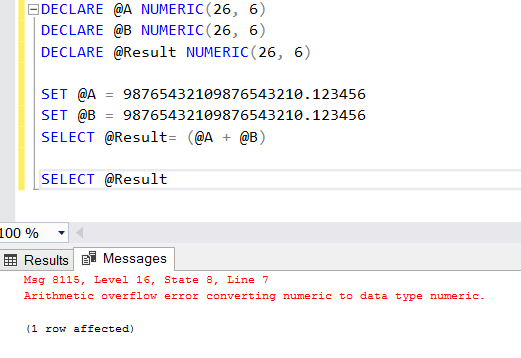

# With ARITHABORT and ANSI warnings disabled - Returns NULL for 999999 but 1.10 as expected # Select data without any casting - works Here is a quick example: SET ANSI_NULLS ONĬREATE TABLE. I still can't get the export to work, even if I set the NUMERIC_ROUNDABORT and ARITHABORT properties to OFF.įor instance, using SET ARITHABORT OFF & SET ANSI_WARNINGS OFF will NULL the values it fails to cast (instead of throwing exceptions) I've marked HeavenCore's response as the answer because it does address my question but it hasn't solved my underlying problem.Īfter a bit of troubleshooting and attempts at trying to get my export to work, I'm going to have to try a different approach. How and what SET statement can I define on a table view that will ignore all of thee arithmetic overflows and write a null value in the fields with errant data?

I would like to know why this is happening but, again, my original question still stands. However, I have no clue how this could happen since I each field to a decimal(12, 5).
SQL SERVER ARITHMETIC OVERFLOW ERROR CODE
I assumed that I must have made a mistake in one of my casting statements but after searching throughout the code for the table view, there is no definition for a decimal(13, 5) field?! My only guess is that the definition that SSMS sees of the view field must be derived from resulting data. In the SSMS Object Explorer, I expanded the Views->-Columns section and I saw that one of the fields was defined as a decimal (13, 5). I decided to see how SSMS "saw" my data view. AS DECIMAL(12, 5)) clauses.īy chance, I stumbled upon an oddity. Since these fields need to fit in fields within the table that are defined as decimal (12, 5), I always wrap the view field statements in a CAST(. Through out my table view, I have various fields that are calculated. I know fixing the definitions that cause the occasional overflow is the most ideal solution, but in this circumstance, it is much more efficient to just ignore these type of errors because they happen on such a rare basis and are so difficult to troubleshoot.īy chance, I believe I might have found the root cause of the issue, however, I have no idea why this would be occurring. In this case, however, the code is both extremely complex and proprietary. I know for most of us, as SO answerers, our first inclination is to ask for code. Is there a way that I can set these SQL properties to ignore rounding errors so that I can export my data from my data view? Next, I tried adding two extended properties to the Data View, hoping that that would work. I assume this is because the error is technically taking place from within the code associated with the data view. to the beginning of the SP and that didn't help. My stored procedure is nothing more than a TRUNCATE and INSERT statement.

These sounds like the perfect options for solving my problem, however, I can't seem to get them to work with either my data view or stored procedure. With that said, I've read about the two SQL settings NUMERIC_ROUNDABORT and ARITHABORT. Debugging and finding the specific, errant field can be very hard and time consuming. The parent table consists of a few hundred thousand records and the result set from the export is well over 1,000,000 records in size.įor most nights the exportation process works without any trouble, however, if a user enters an incorrect value within our master ERP system, it will crash the nightly process because one of the decimal fields will contain a value that doesn't fit within some of the conversions that I have to make on the data. I have a complex data view that recursively links and summarizes information.Įach night a scheduled task runs a stored procedure that selects all of the data from the data view, and inserts it into a table so that users can query and analyze the data much more quickly than running a select statement on the data view.


 0 kommentar(er)
0 kommentar(er)
